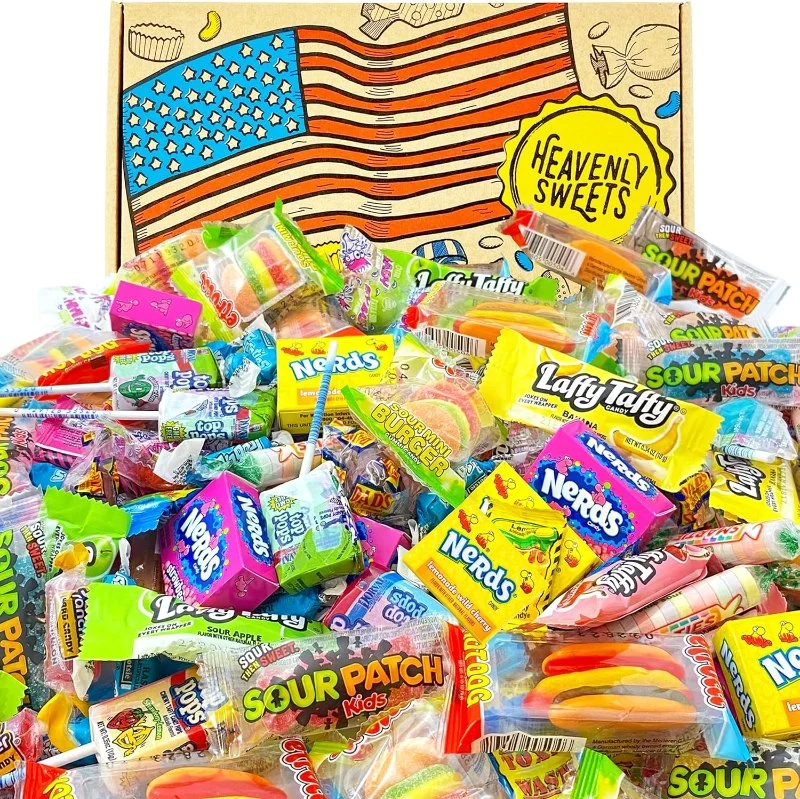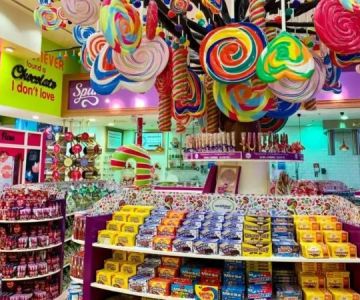
How Candy Shapes American Pop Culture
- The History of Candy in American Pop Culture
- Candy as Pop Culture Symbols
- Candy in Entertainment and Media
- Candy in Advertising and Marketing
- Candy and American Holidays
- Conclusion: Candy’s Enduring Role in Pop Culture
1. The History of Candy in American Pop Culture
Candy has long been an integral part of American culture, often more than just a sweet treat. From its role in childhood memories to its iconic status in various celebrations and holidays, candy has shaped the way Americans view indulgence, pleasure, and nostalgia. In the early 20th century, mass-produced candy like Hershey's chocolate bars, Reese's Peanut Butter Cups, and M&Ms became staples in American households, making candy a readily available comfort food for people of all ages.
Throughout the decades, candy not only became a part of everyday life but also began to carve its place in pop culture. From films to TV shows and advertisements, candy symbols became synonymous with childhood innocence, love, and excitement. Let’s explore how candy has evolved and continued to influence American pop culture.

Lily Grapes USA LLC / candy grapes near me
1320 Westmont Rd SW, Atlanta, GA 30311, USA
2. Candy as Pop Culture Symbols
Candy often represents more than just sugar and sweetness—it symbolizes joy, celebration, and sometimes, even rebellion. Iconic candy brands have achieved such prominence that they have become symbols in their own right, often representing certain aspects of American identity.

Hatch Family Chocolates / hatch family chocolates
Salt Lake CitySalt Lake CountyUtah
376 8th Ave A, Salt Lake City, UT 84103, USA
2.1 The Role of Candy in Movies and TV Shows
One of the clearest ways that candy has shaped American pop culture is through its frequent appearances in movies and TV shows. In Willy Wonka & the Chocolate Factory, candy is not just a treat but a gateway to an enchanting world, sparking imaginations of all ages. Similarly, in the Harry Potter series, magical candies like Chocolate Frogs and Bertie Bott’s Every Flavor Beans have captured the imaginations of audiences worldwide. These references in media showcase candy as something special, with the power to transport us into whimsical, fantasy realms.
2.2 Candy as an Iconic American Element
Candy brands such as Hershey’s and Mars have evolved into more than just companies—they have become symbols of American culture. When people think of chocolate, images of Hershey’s Kisses or Snickers bars often come to mind, signifying a deeply ingrained part of the nation’s food culture. Over the years, these candy brands have shaped the way Americans interact with food and indulging in treats. Furthermore, candy is often tied to the concept of nostalgia, evoking memories of simpler times and childhood joy.
3. Candy in Entertainment and Media
The connection between candy and entertainment is undeniable. Candy’s role in films, advertisements, and music has contributed to its lasting place in pop culture. Through its widespread portrayal in the media, candy has become a symbol of happiness, indulgence, and celebration.
3.1 Candy in Film and Television
Candy’s prominence in movies isn’t just limited to a few classics. Throughout the years, we’ve seen candy featured in many films as an essential part of the narrative. From Charlie and the Chocolate Factory to Ghostbusters, candy is often used as a metaphor for indulgence, youth, or even a quirky sense of humor. In modern films, candy continues to play a role in storytelling, as seen in the 2017 hit It, where candy is woven into the narrative to show the innocence and terror experienced by the characters. These portrayals make candy a familiar, nostalgic element in American cinema.
3.2 Candy in Advertising and Marketing
Candy companies have long been experts in advertising, often creating memorable campaigns that tap into the emotions of the audience. From the “M&M’s Spokescandies” to iconic slogans like “Have a Break, Have a Kit Kat,” candy companies have used advertising to solidify their position in pop culture. The catchy jingles and memorable mascots of candy brands have made them some of the most recognizable names in marketing history.
4. Candy in Advertising and Marketing
Candy brands have capitalized on the emotional connection people have with their products by creating advertisements that resonate deeply with audiences. Through the years, candy commercials have used humor, heartwarming themes, and even pop culture references to capture attention.
4.1 Creative Campaigns
Some candy brands, like Skittles, have garnered attention for their unconventional advertising. Skittles has used humor and surrealism to create viral campaigns, often featuring absurd situations and humorous twists. These campaigns are often shared widely on social media, making Skittles synonymous with creativity and out-of-the-box thinking.
4.2 Candy and Holidays
Candy is often linked to specific holidays, especially Halloween, Christmas, and Easter. The relationship between candy and holidays is so strong that certain candies have become synonymous with the celebrations themselves. For instance, Halloween wouldn’t be complete without trick-or-treating for candy, and Easter is known for its chocolate eggs and jelly beans. The commercial success of candy brands during these holidays showcases the powerful link between candy and American traditions.
5. Candy and American Holidays
Candy plays a major role in American holidays, adding to the festive atmosphere and offering a sense of tradition and enjoyment. While candy is enjoyed year-round, certain holidays are particularly tied to sweet treats, influencing both the candy industry and pop culture.
5.1 Halloween: The Ultimate Candy Holiday
Halloween is arguably the most iconic holiday for candy consumption in the United States. Trick-or-treating is a beloved tradition that involves children (and adults) collecting candy from their neighbors. Candy companies see a significant boost in sales during this time, and popular Halloween candies, like Reese’s Peanut Butter Cups and Snickers, become staples of the season. The imagery of candy and costumes has become central to the American experience of Halloween, making it a cultural phenomenon.
5.2 Candy and Christmas
Christmas, too, has its fair share of candy traditions. Candy canes, chocolate stockings, and holiday-themed treats are all part of the celebration. These candy traditions are often passed down through generations, adding to the sentimental value of sweet treats during the holiday season.
5.3 Candy in Easter
At Easter, candy like chocolate bunnies, jelly beans, and Cadbury eggs are popular gifts and treats. The tradition of Easter candy has been a part of American culture for decades, with candy brands releasing limited edition holiday treats that evoke feelings of joy and indulgence.
6. Conclusion: Candy’s Enduring Role in Pop Culture
Candy has played an enduring and transformative role in American pop culture. From its roots in early advertising to its place in holiday traditions and media, candy is more than just a sweet treat—it’s a symbol of celebration, nostalgia, and indulgence. Whether in a classic TV show, a movie scene, or a memorable ad campaign, candy continues to shape the way we experience culture and emotion. As the candy industry continues to evolve, its place in American pop culture remains as sweet as ever.







 San Francisco Chocolate Store4.0 (377 reviews)
San Francisco Chocolate Store4.0 (377 reviews) Sweet Lovable Chocolates5.0 (10 reviews)
Sweet Lovable Chocolates5.0 (10 reviews) Gertrude Hawk Chocolates4.0 (94 reviews)
Gertrude Hawk Chocolates4.0 (94 reviews) 86 St Candy Store4.0 (3 reviews)
86 St Candy Store4.0 (3 reviews) Candy Land4.0 (44 reviews)
Candy Land4.0 (44 reviews) KO Treats: Taste of the Valley5.0 (4 reviews)
KO Treats: Taste of the Valley5.0 (4 reviews) Top Candy Shops for Tourists in New York – Best Sweets and Treats
Top Candy Shops for Tourists in New York – Best Sweets and Treats Best Candy Shops in New York - A Sweet Adventure Through the City
Best Candy Shops in New York - A Sweet Adventure Through the City How to Make Candy-Themed Crafts for Christmas Gift Giving
How to Make Candy-Themed Crafts for Christmas Gift Giving How to Make Chocolate-Covered Strawberries for Kids: A Fun and Easy Recipe
How to Make Chocolate-Covered Strawberries for Kids: A Fun and Easy Recipe How to Make Easy Gummy Worms at Home | Homemade Candy Recipes
How to Make Easy Gummy Worms at Home | Homemade Candy Recipes How to Host a Candy-Themed Movie Night | Fun and Sweet Ideas
How to Host a Candy-Themed Movie Night | Fun and Sweet Ideas